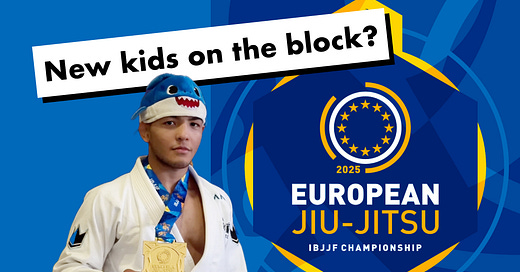AOJ and Melqui Galvao teams sweep Euros, top teams bring minimal white belts
A data-driven look at the IBJJF European matches
I analyzed over 6,000 matches from the 2025 IBJJF European Championship last week. Since its the first gi major of the “grand slam” circuit, we can see which teams to keep an eye on throughout the season.
AOJ and Melqui Galvao wipe the competition overall.
I took a look at teams who participated in over 50 matches throughout the week-long tournament. AOJ, Melqui Galvao, Marcio Andre, Fratres, Atos and Alliance all stand out as teams with over a 60 percent win rate. AOJ and Melqui Galvao were neck and neck with over 75 percent wins, both bringing relatively smaller teams. Of the “powerhouse” huge affiliations, Alliance was able to preserve a 62 percent win rate over 350 matches.
There are some smaller European schools and affiliations have a strong showing, especially Mako Team Paris (colloquially known as MK Team) winning 59 percent of their 86 matches.
Alliance had a good showing for such a large team.
From plotting win rate over number of matches, we can see the vast majority of teams bring enough athletes for somewhere between 50 and 100 matches, hovering between 40 and 60 percent success.
This visual below shows how Alliance’s quality control stands out among large teams; GF Team, Gracie Barra and Checkmat were the other large affiliations with more than 350 matches, and all had around 10 percent less success, around 50 percent win rate at Euros.
Where are the white belts?
When teams are broken down by rank, it’s interesting to see that the top four competition teams have virtually no white belt athletes (Melqui Galvao brought two). Vision and Double Five also made the top ten ranks with no white belts, the the other teams didn’t bring many either. One might wonder if competition teams see white belts as too much of a wild card for majors, or if they abide by some philosophy that major tournaments aren’t useful to athletes in that stage of development.
Melqui Galvao’s had the highest percentage of blue belt matches, and only a handful of purple and black belt matches (no brown belts!). His team will be one to watch as the athletes age into the upper ranks.
Top performers by belt
Here were the top performers by rank:
Blue: AOJ and Melqui Galvao team won 80 percent or more of their matches
Purple: Highest of all the team ranked groups, Marcio Andre’s purple belts won 85 percent of their matches.
Brown: AOJ and Atos brown belts won more than three quarters of their matches.
Black: AOJ, Melqui Galvao and Double Five black belts 70 percent of their matches.
Top competition teams were made of predominantly juvenile and adult athletes.
All of the top ten teams had more juveniles and adult matches than masters, except MK Team. We might consider MK Team less of a “professional” jiu-jitsu team that still had their “middle aged” athletes do extremely well. Fratres and Vision had relatively few juvenile matches compared to the other competition teams. One might wonder if their recruiting process for athletes starts later on, compared to other schools who home grow their athletes or have scalable juvenile programs.
Cicero Costha juveniles won all 14 of their matches at Euros. AOJ and Melqui Galvao juveniles and adults were consistently winning about 80 percent of the time. There is an overall trend of juveniles and adults outperforming masters athletes until we hit 7th on the list, with MK Team, Cicero Costha, and Double Five master athletes having an edge over adult competitors.
Just for fun, a bit about white belts.
The top winning competition teams didn’t bring a lot of white belts, but other academies certainly leaned into theirs. Forty-nine percent of Cens Academy and 58 percent of Academie Caio Terra matches were white belt matches, they did pretty well too, winning 67 and 70 percent of their matches respectively.
Random “fun” facts from Europeans
50 athletes were disqualified for being overweight, distributed pretty randomly across all belt ranks.
There were 23 default gold medals awarded, predominantly in the heavier, older masters divisions.
From BJJHeroes’ wrap up of Euros: Among 190 adult black belt matches, “we witnessed 90 matches won by 2 points or less (68 male matches – 36% & 22 female matches – 39%)”



This is great. Thanks a lot!
I’m really enjoying your posts and analysis. It may be too niche, but I’d be interested to learn more about how you gather and analyze the data. Thanks for the great work on these!